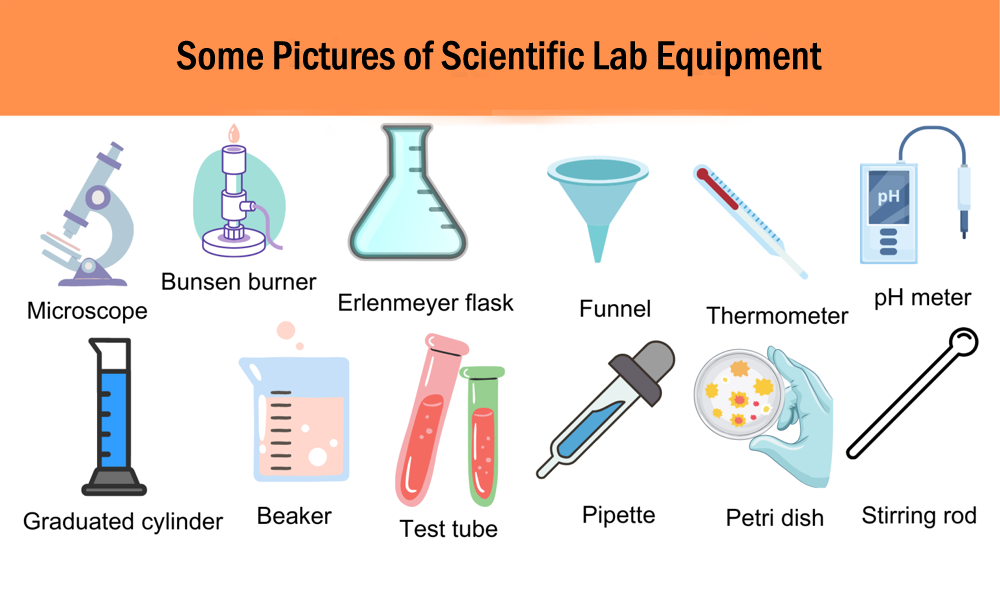Scientific research relies heavily on accurate experimentation and observation. In any laboratory, whether it’s a biology, chemistry, physics, or multidisciplinary lab, having the right equipment is crucial for conducting research, making discoveries, and ensuring safety. This blog provides an overview of the most essential pieces of scientific lab equipment, their functions, and their importance in scientific work.
Some Scientific Lab Equipment are given below as an example:
1. Microscopes
Microscopes are among the most widely used pieces of lab equipment, especially in biology and medical research. They enable scientists to observe organisms, cells, and structures that are too small to be seen with the naked eye.
- Light Microscopes: Common in schools and basic research labs, they use visible light to magnify objects.
- Electron Microscopes: These are more advanced, using beams of electrons to achieve much higher magnification and resolution, ideal for viewing ultrastructural details.
- Digital Microscopes: For Electronics work digital microscopes are very helpful in making easier work.
Why They Matter: Microscopes allow scientists to understand cellular processes, diagnose diseases, and study microorganisms.
2. Centrifuges
A centrifuge separates substances of different densities using high-speed spinning. It’s an essential tool in chemistry and biology labs for processes such as separating blood components, purifying proteins, and isolating DNA.
- Ultracentrifuges: These can rotate at extremely high speeds to separate even the smallest particles.
- Refrigerated Centrifuges: Often used in biological labs to keep samples cold while spinning.
Why They Matter: Centrifuges allow for the precise isolation and preparation of different substances, which is critical for molecular biology, biochemistry, and medical diagnostics.
3. Beakers and Flasks
No chemistry lab would be complete without beakers and flasks. These simple but vital glassware tools are used for holding, mixing, and heating liquids.
- Beakers: Cylindrical with a flat bottom, ideal for stirring and mixing chemicals.
- Erlenmeyer Flasks: Feature a conical shape with a narrow neck, making them great for heating substances while minimizing evaporation.
- Volumetric Flasks: Calibrated for precise measurement of liquid volumes, commonly used in titrations.
Why They Matter: These vessels are fundamental for handling, reacting, and safely storing chemicals.
4. Pipettes
Pipettes are precision tools used to measure and transfer small volumes of liquids. They come in several types, from simple glass pipettes to highly advanced electronic models.
- Micropipettes: Used in molecular biology, these can measure tiny volumes with incredible accuracy.
- Serological Pipettes: Ideal for transferring larger volumes of liquid in cell culture and biology labs.
Why They Matter: Pipettes ensure that experiments involving liquid handling are precise, minimizing the risk of contamination and experimental error.
5. Balances and Scales
Measuring mass accurately is a core requirement in most scientific experiments, especially in chemistry. Analytical balances are extremely sensitive, offering precision to a fraction of a milligram.
- Analytical Balances: Offer high precision for small quantities of material.
- Top-Loading Balances: Used for larger, less sensitive measurements.
Why They Matter: Accurate weighing of substances ensures the integrity and reproducibility of experiments, particularly in quantitative research.
6. Bunsen Burners
Bunsen burners provide a single open flame used for heating, sterilization, and combustion in chemical labs. They are named after German chemist Robert Bunsen, who developed the device in the 19th century.
Why They Matter: Bunsen burners are essential for tasks that require consistent and controllable heating, like conducting flame tests or sterilizing equipment.
7. Autoclaves
Autoclaves are used to sterilize equipment and media using high-pressure steam. They are crucial in any lab that works with biological samples to prevent contamination.
Why They Matter: Autoclaves ensure that glassware, tools, and culture media are free from harmful microorganisms, which is critical for maintaining the integrity of biological experiments.
8. Spectrophotometers
Spectrophotometers measure the absorbance or transmittance of light through a liquid sample. This tool is especially important in chemistry, biology, and materials science for analyzing the concentration of solutes in a solution.
Why They Matter: Spectrophotometry provides a quantitative method for analyzing chemical and biological samples, enabling precise monitoring of reactions, concentration measurements, and even DNA quantification.
9. Thermometers and pH Meters
Environmental conditions like temperature and acidity play crucial roles in many experiments. Labs use thermometers and pH meters to monitor these variables accurately.
- Thermometers: Measure the temperature of liquids or the ambient lab environment.
- pH Meters: These devices provide an exact measurement of the acidity or alkalinity of a solution, which is critical in many chemical reactions and biological processes.
Why They Matter: Consistent monitoring of temperature and pH levels ensures that experimental conditions are controlled, leading to more reliable results.
10. Fume Hoods
Fume hoods are designed to remove harmful vapors and fumes from the laboratory environment. They are essential for protecting scientists when working with hazardous or volatile substances.
Why They Matter: Fume hoods are a critical safety measure, preventing exposure to dangerous chemicals and ensuring a clean air environment for researchers.
Conclusion of Scientific Lab Equipment:
From microscopes that reveal the unseen world to spectrophotometers that quantify light absorption, scientific lab equipment is the foundation of experimental work. Each tool, whether for measuring, heating, or mixing, plays an essential role in the discovery process, making it possible to conduct experiments accurately and safely.
In research, precision is everything—and the right equipment is the key to unlocking innovation. Whether you’re a student, an academic, or a professional researcher, understanding the importance and proper use of lab equipment is fundamental to the scientific process.



